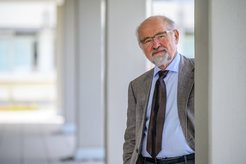Stefan Hell and Erwin Neher elected as Honorary Fellows by the International Union of Physiological Sciences
“I feel very honored that the IUPS has selected me as an Honorary Fellow,” says Hell, Director of the Department of NanoBiophotonics. Emeritus Director Neher, head of the Emeritus Group of Membrane Biophysics, adds, “I was Vice President of the IUPS in the late 1980s and I still feel very connected to the society, so I am particularly pleased by this recognition.” In addition to Hell and Neher, Nobel laureate Peter C. Agre of the Johns Hopkins Bloomberg School of Public Health (USA) was was announced as IUPS Honorary Fellow.
It cannot get sharper

With his invention of STED microscopy, Hell was the first to overcome the diffraction limit of light in fluorescence microscopy, thus revolutionizing the field. Until then, it was believed that the light microscopes are physically limited to a resolution of about 200 nanometers (millionths of a millimeter). However, for the first time STED achieved a resolution of up to 20 nanometers, which is around ten times sharper than conventional microscopes. For this breakthrough, the physicist received the Nobel Prize in Chemistry in 2014. Since then, the Max Planck researcher achieved to increase the resolution by another tenfold: His subsequent developments MINFLUX and MINSTED, both harnessing key features of the original STED principle, achieve a resolution of a few nanometers. This allows to optically separate neighboring molecules from one another – it cannot get any sharper. It is also possible to locate and track individual molecules with single nanometer precision in living cells by light microscopy. This offers new perspectives for cell biological, physiological, and medical research.
Hell studied physics in Heidelberg. After receiving his PhD in 1990, he was a postdoctoral fellow at the European Molecular Biology Laboratory (EMBL) in Heidelberg and moved to the University of Turku (Finland) in 1993. There, he developed the principle of STED microscopy. In 1997, the physicist joined the MPI for Biophysical Chemistry in Göttingen as head of a Max Planck junior research group, where where he and his co-workers demonstrated the method’s principle and developed the technique. In 2002, Hell was appointed as director at the institute and has since headed the Department of NanoBiophotonics. Since 2016, he is also director at the MPI for Medical Research in Heidelberg. In addition to the Nobel Prize in Chemistry, the scientist received numerous other prizes, including the Gottfried Wilhelm Leibniz Prize of the German Research Foundation (2008), the Otto Hahn Prize in Physics (2009), the Körber European Science Prize (2011) and the Kavli Prize in Nanoscience (2014).
Milestone in research on cell communication

In 1976, physicist Neher and his colleague Bert Sakmann developed a method that enabled them to measure the weak electric current flowing through individual ion channels in nerve cells for the first time – the so-called patch clamp technique. For this accomplishment, the two scientists were awarded the Nobel Prize in Physiology or Medicine in 1991. Ion channels are pore-forming proteins in the outer membrane of living cells. They play an important role in signal transduction in the nervous system, but are also important for blood, immune, and liver cells. The patch-clamp technique revolutionized electrophysiological research and is now a standard in laboratories worldwide. With the help of this method, the causes of a number of diseases based on malfunctioning ion channels could be identified, including cystic fibrosis – a metabolic disease of the bronchial tubes.
Neher studied physics at the Technical University of Munich and at the University of Wisconsin/Madison (USA). After completing his PhD in 1970 at the MPI of Psychiatry (today: MPI of Neurobiology) in Munich, he was a research fellow at Yale University (USA). From 1983, Neher was director at the MPI for Biophysical Chemistry, where he headed the Department of Membrane Biophysics. After his retirement in 2011, he continues his research at the institute with an emeritus group. In addition to the Nobel Prize in Physiology or Medicine, he received numerous other awards and honors, including the Gottfried Wilhelm Leibniz Prize of the German Research Foundation (1987).
About the International Union of Physiological Sciences (IUPS)
The IUPS is an international non-profit collective organization uniting national societies from all continents in the field of physiological research. It is headquartered in Washington D.C. (USA). Since it was founded in 1953, the union has promoted international science in the field of physiology and worked to overcome political barriers to facilitate the exchange between physiologists. (is/cr/fk)

